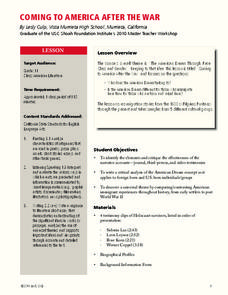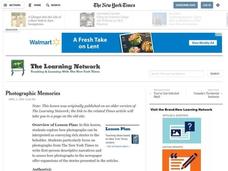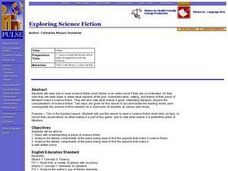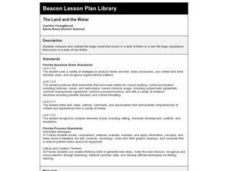Curated OER
Scene Writing: Literacy and Playwriting
Drama is ever-present in our daily lives and eloquently depicted on stage. Middle schoolers practice writing scenes based on different prompts and frameworks, and then perform those creative scenes for their classmates. The...
Novelinks
Tuck Everlasting: Similes, Metaphors, and Personification in Imagery
Poetic language is abundant in Natalie Babbitt's beautiful novel, Tuck Everlasting. Learners note the examples of similes, metaphors, and personification they find as they read, and illustrate how the language creates a sensory...
K20 LEARN
Writing An Argumentative Paragraph: Argumentative Writing
Learning how to craft a cogent argument based on a solid claim, supported with evidence and solid reasoning, is an important life skill. Teach middle schoolers about argumentative writing with a lesson asking them to analyze the claims,...
Curated OER
Marvelous Mysteries
Fifth graders explore mystery stories. For this reading and writing lesson, 5th graders complete a planning guide for an original mystery. Students use the writing process to create a mystery story.
Curated OER
Diary of Anne Frank: Act 1 Scene 1 & 2
Eighth graders read act 1 scenes 1 & 2 of the play Diary of Anne Frank. In this Diary of Anne Frank lesson plan, 8th graders discuss how the setting of the play affects the mood of the story and answer short answer questions.
Curated OER
The Cask of Amontillado
Students examine the Edgar Allan Poe story "The Cask of Amontillado." In this character lesson, students discuss and analyze the characters in the story. Students make personal connections to the characters and create a brochure...
Curated OER
B-movies and Plot: Story Elements, Writing, Media
Pupils use old "B-Movies" as a springboard to discuss and analyze traditional plot structures. They form groups and make their own 'movie' to demonstrate their knowledge.
Curated OER
Reading Stories in Art
Students study how artists tell stories using visual images by identifying and comparing elements of narrative (setting, characters, and plot) in a painting and a Greek vase.
University of Southern California
Coming to America After the War
As part of their exploration of the American dream, class members examine primary source materials to compare immigrant experiences of those arriving early in our country's history to those arriving in the US after World War...
Curated OER
Photographic Memories
Explore how photographs can represent a whole story to a viewer. Middle schoolers work on narrative writing techniques in this lesson, focusing on photographs from the New York Times to write first-person descriptive narratives....
Curated OER
Creating Characters
Students examine the methods of effective characterization. In this writing skills lesson, students discuss how emotions, dialogue, actions, and physical descriptions build believable characters. Students then use the methods of...
Curated OER
A Study Guide for The Phantom of the Opera
Immerse yourself in the beautiful, twisted world of Andrew Lloyd Webber's The Phantom of the Opera. A detailed lesson plan provides important details about the writing, stagecraft, music, and literary elements of the famous musical,...
Curated OER
A Novel Ending/ Closure Activity
Students summarize a story, identify the plot structure, and create a symbol that represents the essence of the story.
Curated OER
A Separate Peace: Chapter 10 Reading and Study Guide
For this comprehension check worksheet, students define 3 vocabulary words, define 2 literary terms, and respond to 10 short answer questions pertaining to chapter 10 of A Separate Peace by John Knowles in order to help them better...
Curated OER
A Separate Peace: Chapter 13 Reading And Study Guide
In this comprehension check worksheet, students define 3 vocabulary words, define 1 literary term, and respond to 6 short answer questions pertaining to chapter 13 of A Separate Peace by John Knowlesin order to help them better...
Curated OER
Outline and Shine
Seventh graders read and discuss a short story. They complete an outline of the story. They pair and share to evaluate each other's outlines.
Curated OER
"The Fall of the House of Usher" by Edgar Allan Poe
High schoolers read and analyze the short story "The Fall of the House of Usher" by Edgar Allan Poe. They take notes while reading the story, select an element to analyze, and write an essay about the characters, theme, or the setting.
Curated OER
Mayan Myths/Folktales
Middle schoolers work on summarizing a story, and they determine if it is a legend, a myth, or a fable. Working in groups to read and summarize stories, they then list evidence whether the tale is a myth, fable, or...
Curated OER
Fiction vs. Nonfiction
Students explore fiction and nonfiction writing. They identify the elements of fiction in a short story and identify the criteria necessary in a nonfiction piece. Students distinguish the author's purpose in an expository text,...
Curated OER
Knowledge or Instinct? Jack London's "To Build a Fire"
Young scholars closely read " To Build a Fire," to explore the use of narrative point of view and debate the distinction between knowledge and instinct. The elements of literary naturalism and how they relate to Jack London's work is...
Curated OER
Exploring Science Fiction
Twelfth graders read a variety of science fiction short stories. Using the text, they identify the components that make it science fiction and a well written piece of literature. They record their observations and share them with the...
Curated OER
Storyboard for Persuasive Text
Middle schoolers demonstrate their knowledge of the main elements of a story by creating a storyboard. In this persuasive writing instructional activity students create storyboards that are intended to persuade a director to make a...
Curated OER
The Land and the Water
Third graders read "The Land and the Water," a fictional short story and an article about John F. Kennedy, Jr. and compare and contrast fictional tragedy to a non-fiction tragedy. They fill out a Venn diagram and write an essay using...
Curated OER
Loving Literature
First graders, after having "Are You My Mother?" by P.D. Eastman read to them, participate in group discussions or independentally work to analyze a spreadsheet to identify essential elements in the story and graph their data. In...























